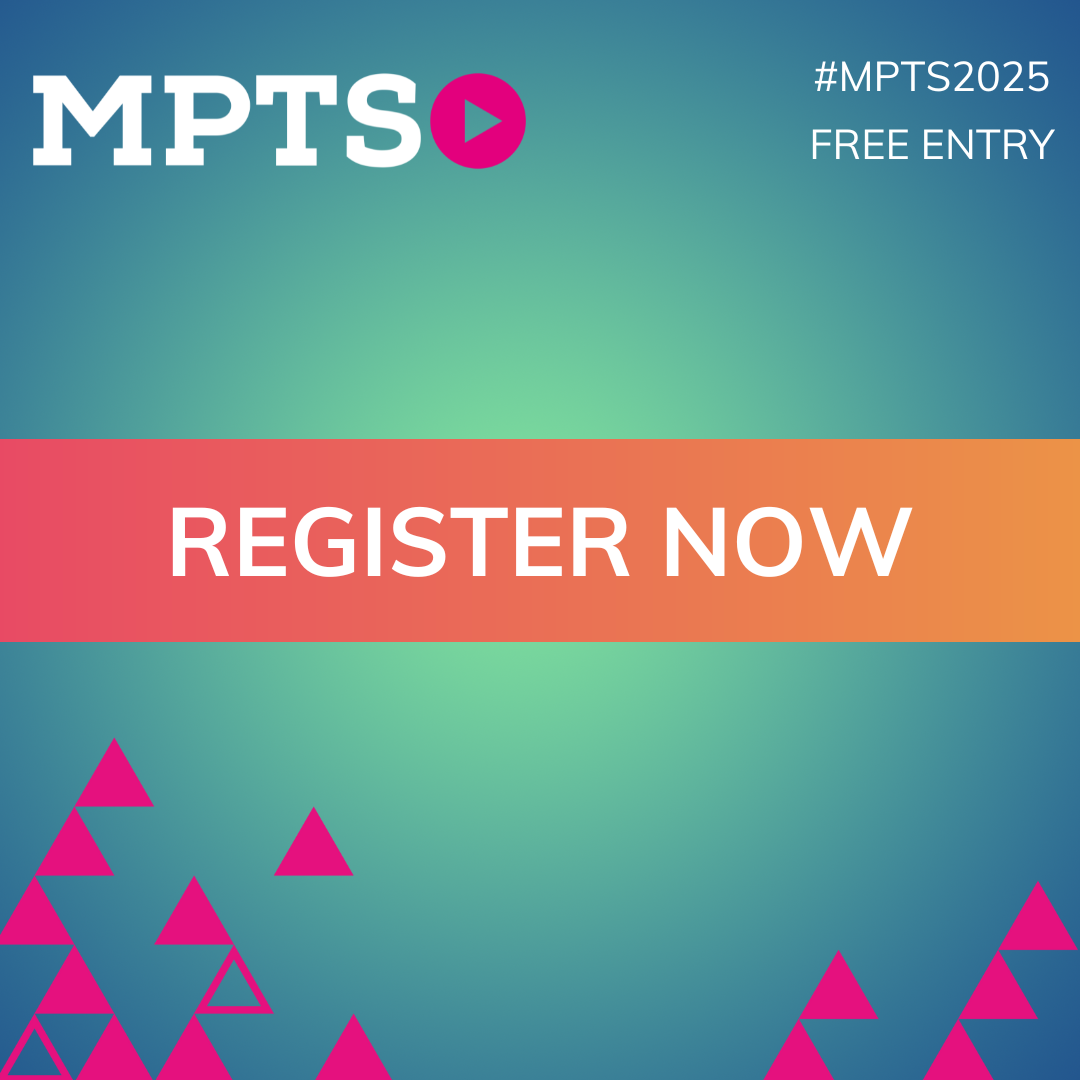Post-production uncovered: Painting Practice on Doctor Who (BBC1)
)
Design studio Painting Practice has revealed the work it put into the 60th anniversary Doctor Who series on BBC1.
The studio worked with Bad Wolf and the BBC from the early development stage of the three episode series in late 2021, as well as the shoot in 2022 and later with VFX teams from Automatik, Untold and Realtime and delivery in 2023. You can read about the work Untold and Realtime put into the series here and here, respectively. Filming took place at Wolf Studios, Cardiff, London and Bristol.
Painting Practice delivered concept design, hybrid virtual production previz, post viz, motion graphics and VFX design and supervision for the three episodes - The Star Beast, Wild Blue Yonder and The Giggle. Co-founder Dan May who was overall VFX supervisor throughout, and Erica McEwan, Painting Practice creative director and graphics art director, also led the team.
Together, they delivered a broad range of visual development and visualisation work spanning all the key environments, features and creatures of the specials. These range from adapting Dave Gibbons and Pat Mills’ comic-book iteration of the Meep and Wrath soldiers for the screen; VFX asset creation, set extensions and previsualisation for the Meep spaceship and escape pod; previsualising the fiery ‘London Cracking’ phenomenon and the Doctor’s regeneration sequence, through to shot design and planning for establishing the Unit Tower; achieving the ‘infinite’ Ghost Ship corridor using hybrid virtual production previsualisation and VFX; developing the brand new Tardis interior as a virtual reality asset; establishing the graphic language for the Doctor’s new Sonic Screen and working out how to make the giant Toymaker’s Theatre fold into a tiny box.
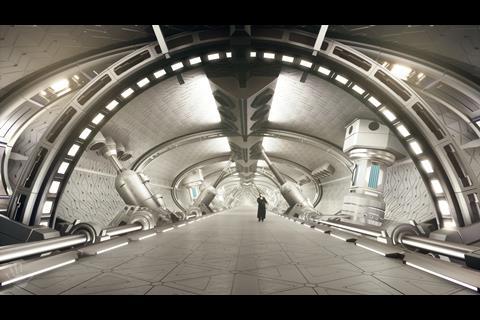
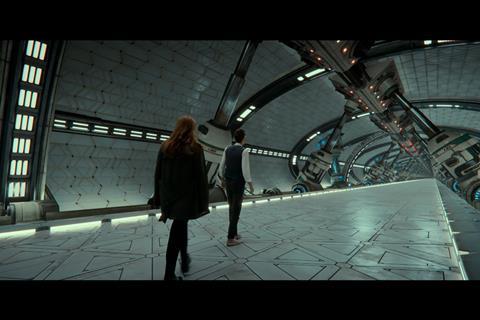
Painting Practice’s hybrid virtual production techniques were key to some of the more complex VFX design challenges of the second episode, Wild Blue Yonder, in which The Doctor and Donna find themselves stranded aboard the Ghost Ship facing their uncanny dopplegangers. May worked with production designer Phil Sims and director Tom Kingsley to design and build the infinite Ghost Ship corridor scenes in Unreal - which you can see the concept and final product of above. This became a digital asset for previsualisation, which was passed to Realtime to take to final pixel. May also supervised the physical green screen shoot with David Tennant, Catherine Tate and the robot. He used the digital corridor asset with Mo-Sys for on set camera tracking, creating instant post vis and a guide for the actors. The challenge in planning and post was ensuring the corridors blended with the real sets. Painting Practice also created and delivered all the eerie exterior Ghost Ship and Drone VFX shots.
Kingsley said, “Working with Dan May and the team at Painting Practice was a really creative and collaborative experience - the most fun bit of the whole production. It was hugely creatively freeing working on pre-vis so quickly and nimbly. It meant we could dream big, sketch out lots of avenues to pursue, and find out if something wasn’t working well in advance of getting to the set.
“We could keep testing out different versions of big action sequences during the writing process - so we could rewrite the script to match the animatic, and keep going back and forth with input from all departments as to what would be most achievable and look the best. I could do a scrappy sketch of an idea, and later that day the brilliant concept artists would have transformed it into something far better, to properly help sell the idea to the execs and showrunner.
“In fact, the concept art was to such a high standard, that the challenge was really to try and make the episode look as good as the concept art.”
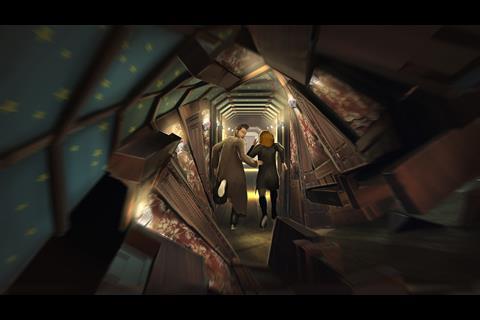
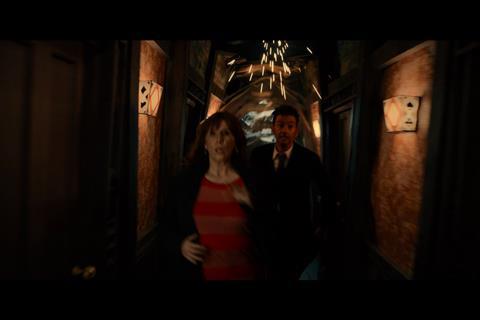
The challenge for The Giggle (episode three) was achieving the cinematic scale required for the introduction of the new Unit Tower in London and its high tech environment, the arrival of the Doctor at the Tower, and in particular the camera move for the regeneration of the Doctor into his fifteenth incarnation. To achieve this May and the Painting Practice team worked closely with director Chanya Button and director of photography Mika Orasmaa to plan and design each shot using a huge range of techniques including puppet rehearsals; 3D storyboarding in Unreal with a virtual camera and set planning; Unreal techvis using scale models of London to plan the helicopter shoots and Unreal rendered previz techniques closely matching the final edit. May then worked closely with Automatik to carry the joined up thinking into the final phase of VFX.
May said: “Our brief from Bad Wolf was to bring some of the high quality production value and design we achieved on His Dark Materials to the Doctor Who franchise, whilst respecting the original tone and iconic heritage of the show. One way we achieved this was by approaching the shot design for each episode on the scale of a mini feature film, and delivering detailed planning to fit this scale into the time and the budget. Our tried and tested mix of creative and technical problem solving can truly be seen in the final episodes.”
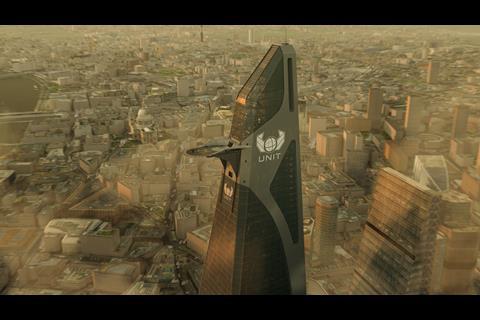
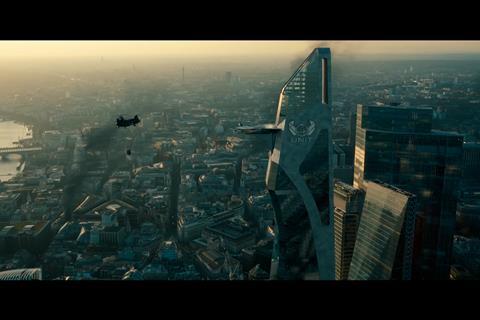
Will Cohen, Doctor Who VFX producer at Bad Wolf, added: “As a digital art department with multiple capabilities, from concept and previz to final pixel, Painting Practice add enormous value to projects with their passion for cinematic storytelling. Their design aesthetic and the depth of their creative thinking put them in a very unique bracket. Their joined up approach was a huge contributing factor to elevating the quality of the VFX work in Doctor Who.”
The other parts of Painting Practice’s work included the design of the 60th Anniversary logo and the design and previsualisation of the new Doctor Who titles. The studio was also commissioned to create the VFX for the recolorisation work on the iconic six-episode series The Daleks, which was broadcast one week ahead of the first special episode.

)
)
)
)
)
)
)
)
)
)
)
)
)
)
)
)
)
)
)
)
)
)
)
)
)
)
)
)
)
)
)
)
)
)
)
)
)
)
)
)
)
)
)
)
)
)
)
)
)
)
)
)
)
)
)
)
)
)
)
)
)
)
)
)
)
)
)
)
)
)
)
)
)
)
)
)
)
)
)
)
)
)
)
)
)
)
)

)
)
)
)
)
)
)
)
)
)
)
)
)
)
)
)
)
)
)
)
)
)
)
)
)
)
)
)
)
)
)
)
)
)
)
)
)
)
)
)
)
)
)
)
)
)
)
)
)
)
)
)
)
)
)
)
)
)
)
)
)
)
)
)
)
)
)
)
)
)
)
)
)
)
)
)
)
)
)
)
)
)
)
)
)
)
)
)
)
)
)
)
)
)
)
)
)
)
)
)
)
)
)
)
)
)
)
)
)
)
)
)
)
)
)
)
)
)
)
)
)
)
)
)
)
)
)

.png/fit-in/500x9999/filters:no_upscale())
)
)
)
)
)
)
)
)
)
)
)
)
)
)
)







